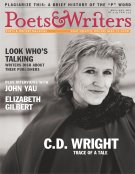Once upon a time there was an aspiring novelist named Maxine H. who was good enough and lucky enough to get an agent who was good enough and lucky enough to sell her novel to the very prestigious XYZ publishing house for an $80,000 advance.
It seemed a fairy tale come true—an auspicious career was about to be launched.
Maxine's became one of 50 books that XYZ's three in-house publicists were pushing that season. They did for her book what they did for the other 49: sent out 200 advance review copies (ARCs) and 400 press releases to all the right people.
The publicists even had the time to make a few dozen follow-up phone calls as Maxine's ARC began to arrive in the offices of newspapers and magazines across the country, one of 300 ARCs that jammed book review editors' in-boxes that month. Or looked at another way, one of 70 that week. Or one of 10 that day.
In addition to the review copies and press releases, XYZ paid a "co-op placement" fee to ensure that the book would have competitive positioning in the New Fiction section of a national bookstore chain. There it competed with 80 other new titles being promoted over the same eight-week period, at the end of which Maxine's novel had received one book review in one big-city newspaper and one in a local magazine.
Other than that there was no press. And there was no author tour—XYZ only sends 10 percent of its authors on tours, the literary-award winners and the celebrity authors of best-sellers. Maxine offered to take herself on tour and bought a ticket to the East Coast, only to discover a week before her departure that her publicist had forgotten to set up any of the readings.
Maxine's book sold only 6,000 copies out of a print run of 15,000. It had a lot of competition and it didn't have a lot of support.
While the main advantage to being published by a big press is the distribution, marketing, promotion, and visibility it can offer, all too often that kind of attention is only bestowed upon the clearly commercial novel that is already earmarked to be a winner, usually because of the author's previous performance. Sessalee Hensley, fiction buyer for all 582 Barnes & Noble superstores, says the sad truth is that only 10 percent of books get any serious marketing or PR support.
To be fair, big publishers don't have the time or the manpower to get behind all the books they publish. Besides, it's not their strategy. The strategy at the big New York houses is to get a lot of books out there and see which ones hit. As a result, over 3,500 novels are published each year (not counting paperback or genre fiction) in the U.S., while at best even the most avid reader buys fewer than 50 of them in a 12-month period.
It wasn't Maxine's fault that her book didn't sell well. But when her agent presented her second novel to XYZ, her editor said that based on the sales and returns of Maxine's first novel and based on what the sales force said the fiction buyers at the bookstores reported back, the house could offer only a quarter of her first advance for her second book.
And that's the good news. At least they wanted Maxine's second novel. Many writers don't get that next chance.
But like fiction itself, Maxine's is not the only story out there.








